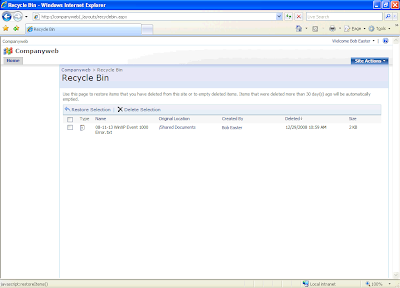All of that has changed with the introduction of Windows SharePoint Services version 3 and the built-in Recycle Bin system.
The catch for us implementing WSS V3 on SBS 2003 was the inherent limitations of the 32bit OS that was already loaded down with a number of different SBS related and third party related services. Thus, we only implemented in a limited number of client settings where WSS would be used, but not cause too much additional stress (especially RAM related) on SBS 2003.
With SBS 2008 and the WSS v3 product that drives the new Companyweb Internal Web site, we are seeing a whole new opportunity. We can utilize the out of the box Companyweb on SBS 2008 to a great extent and not worry too much about RAM or database limitations for our small to medium sized clients.
We have the flexibility to tie Companyweb and any other WSS based Site in an SBS 2008 Premium based installation into SQL 2008 which will give us a lot of headroom when it comes to site performance. Tying SharePoint into SQL 2008 also alleviates much of the data volume concerns we have had to date ... though both site performance and database sizes will be tied to the physical server box's configuration.
Have a client that wants to have an Internet facing WSS v3 site? Then SPLA the Windows OSs needed and SQL 2008 Web Edition for them as that will put their licensing costs at dollars per day depending on the end configuration as opposed to licensing SQL 2008 Web Edition per processor on Open Value or Open License which is very expensive.
So, back to the Recycle Bin business:

Companyweb SharePoint User Recycle Bin
The user has deleted the document, and it now sits in the Recycle Bin waiting for them or someone else to delete it. If there are a large number of items in the bin, clicking on the item selection box just above the first item's check box will select everything.
Okay, in our above screenshot, once deleted from the Recycle Bin where does that document go?
When logged onto a workstation with our Domain Admin account, or on the server itself, we can open the Companyweb site and navigate to the Site Collection Recycle Bin setup:
- Click on Site Actions near the top right of the page
- Click on Site Settings.
- Click on the Recycle Bin link under Site Collection Administration
You will see the following:
SharePoint Admin Recycle Bin - User Bin View
Of course, the User Recycle Bin is empty because the user has already emptied it. Now, there was a momentary lapse of reason on the user's part and they now realize that the file that was deleted from the Recycle Bin was still needed!
Not to fear! We now have a Recycle Bin's Recycle Bin!
SharePoint Admin Recycle Bin - Admin Bin View
We can restore that file! Nice and simple isn't it? :)
Not only that, when we restore that file, it goes back to its original location on the Companyweb site, not back into the User Recycle Bin.
BTW, it is important to note that the Recycle Bin system in WSS v3 also works when the user is using Explorer View to work with site content.
This one feature will save us a huge amount of pain over "lost" or accidentally deleted files on the Companyweb or any other WWS v3 site we manage on behalf of our clients.
Some links for you:
- Microsoft Office Online: View, restore, or delete items in the Recycle Bin
- SBS Companyweb Admin Bin (Internal SBS 2008 link - copy and paste)
- Microsoft Service Providers License Agreement (SPLA) site.
- Microsoft SQL Server 2008: Web
Philip Elder
MPECS Inc.
Microsoft Small Business Specialists
*All Mac on SBS posts are posted on our in-house iMac via the Safari Web browser.


2 comments:
Phil,
Can I also point people towards a video I created that outlines the use of the SharePoint v3 recycle bin at : http://www.youtube.com/watch?v=RVX1Odkxz2I
If you use WSS v3 on SBS2008 Premium you gotta watch the licensing since if user access WSS v3 with an SQL 2008 database then "technically" they require a Premium Cal, is my understanding.
Also, for those wanting to migrate SharePoint to SBS 2008 can I also plug my SharePoint Guide at http://www.wssops.com?
Thanks
Robert
Robert,
Yeah, if we want to publish a site to the Internet we need to look into SPLA or per processor licensing! :*0
No worries. Thanks for the input.
Philip
Post a Comment